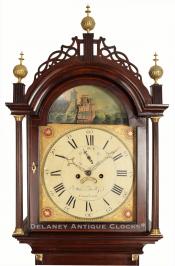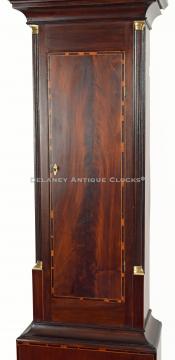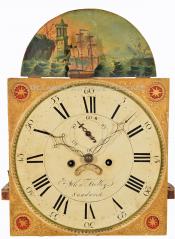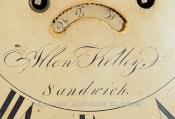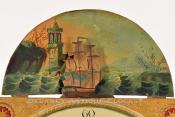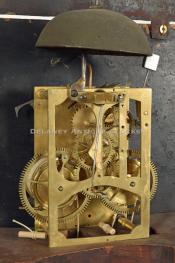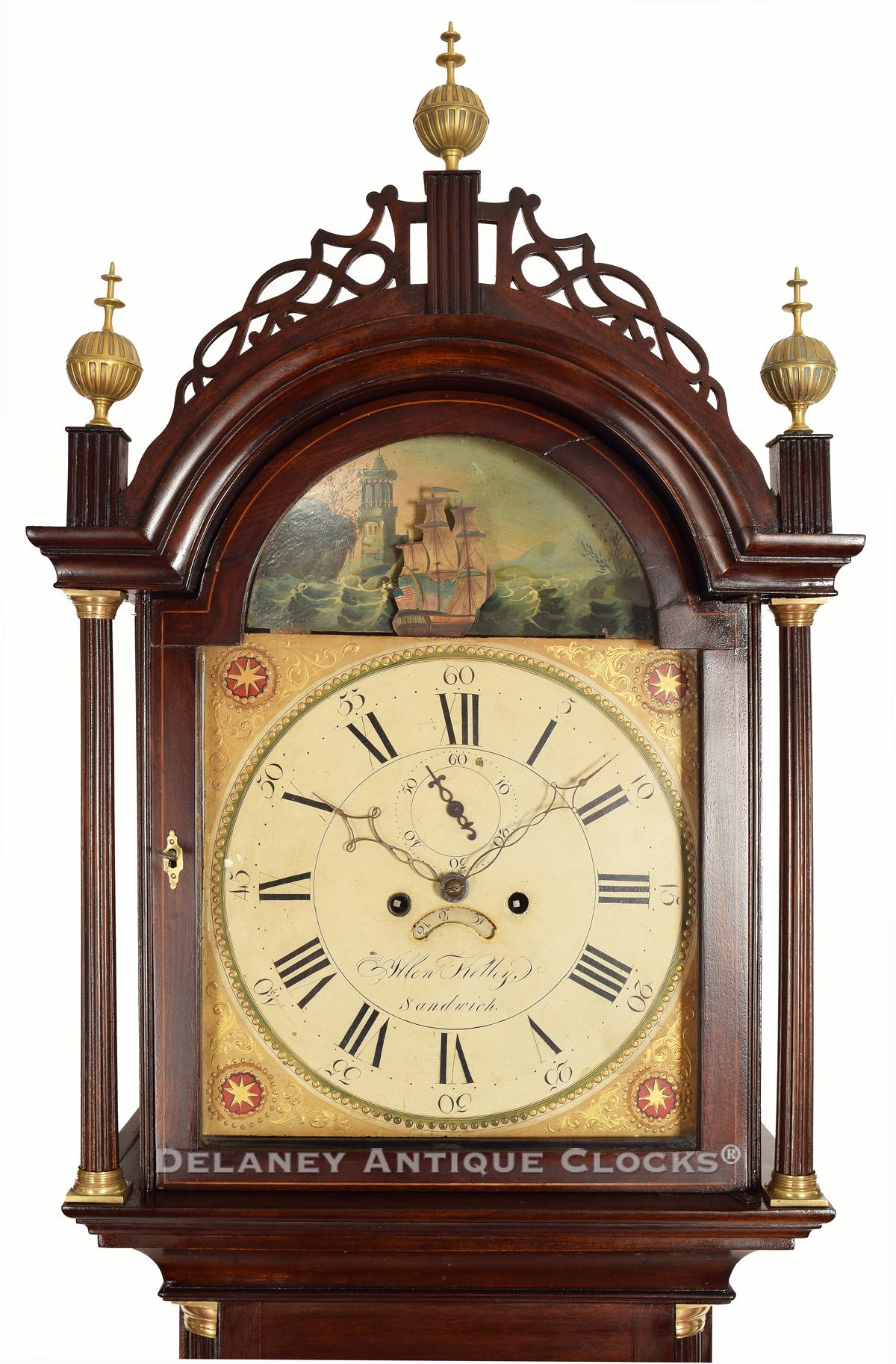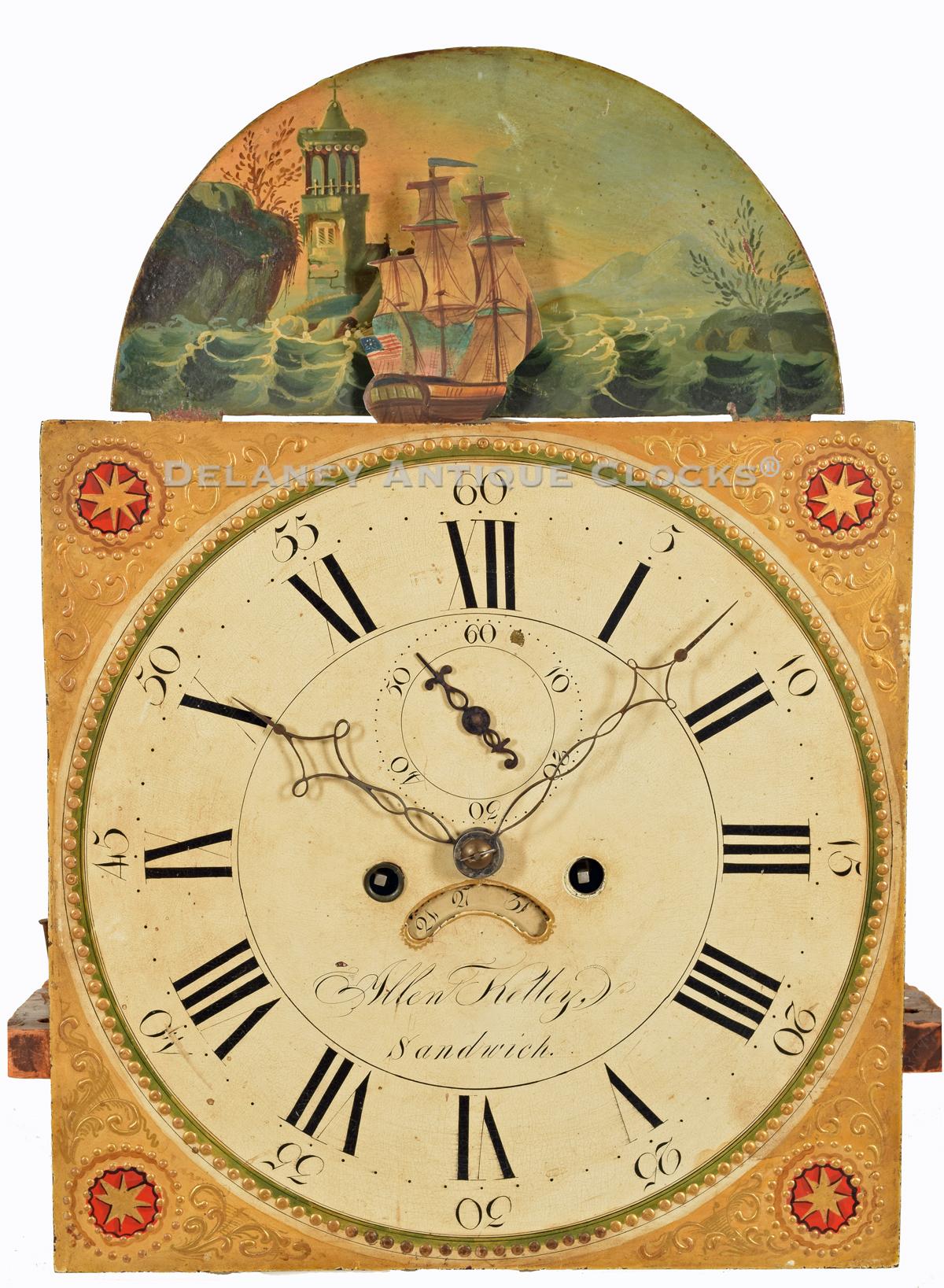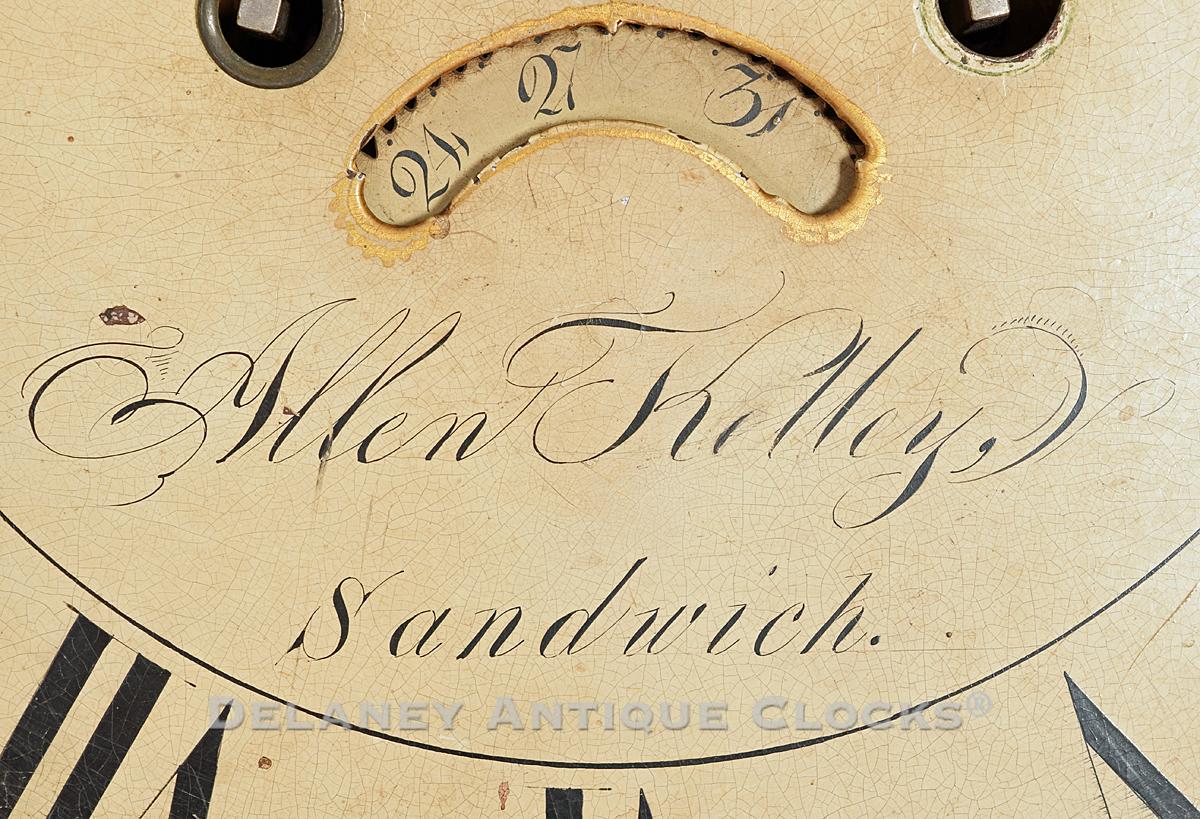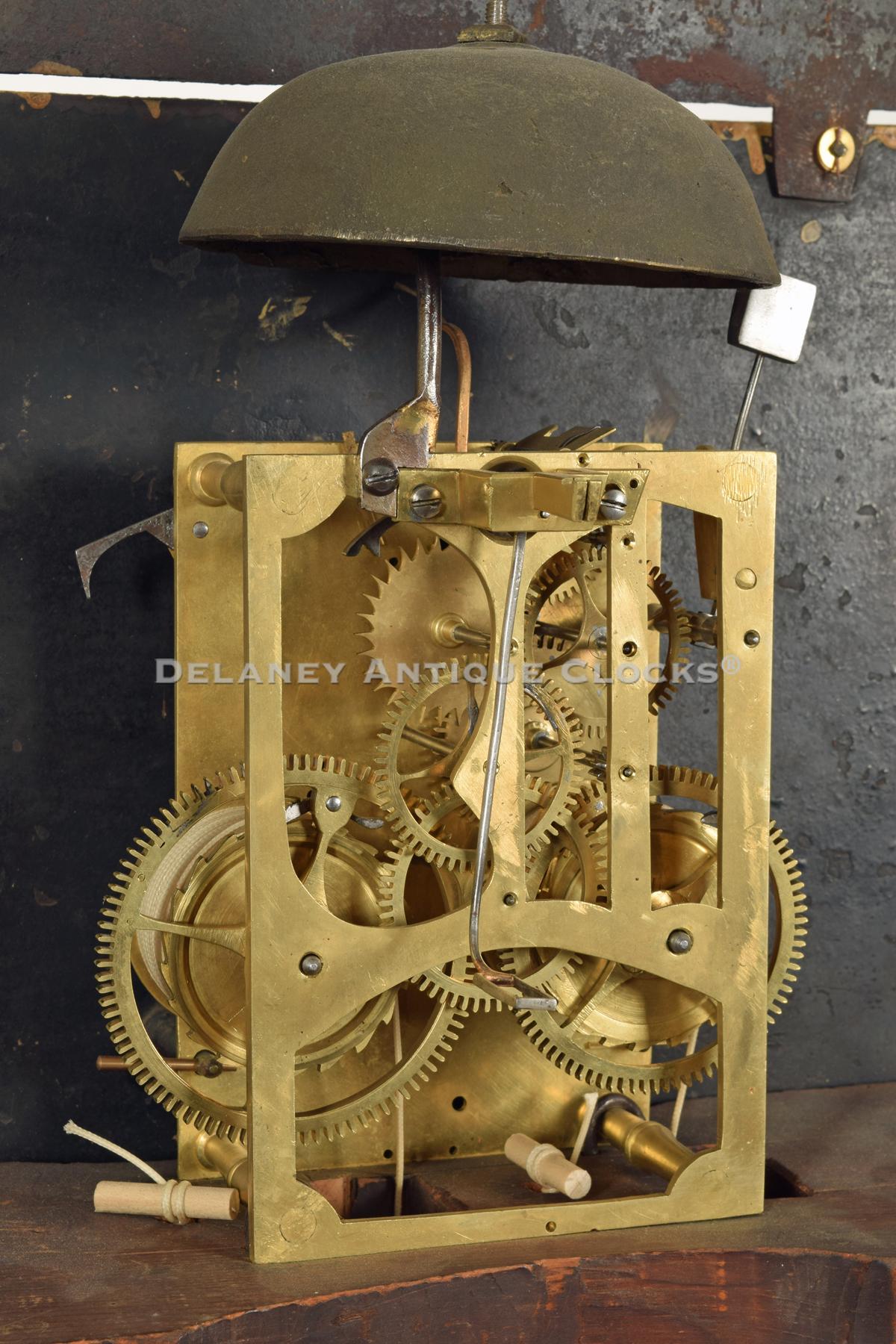Allen Kelley of Sandwich, Massachusetts. An inlaid mahogany case tall clock featuring a rocking ship dial. VV-3.
This very attractive example is constructed in dark mahogany and features light-line inlays. The modern shellac finish enhances the contrast in the natural colors of various wood types. This case stands on four flared French feet. The transition between the feet forms a double apron hanging below the base section. The feet are visually separated from the base section by a thin tiger maple banding. This light-colored inlay starkly contrasts the darker mahogany used in the construction of the case. The front-facing panel of the base is framed with an exciting line pattern. This pattern features two thin lines of maple that frame the cross-banded rosewood middle section. Light sections of wood randomly break up this run of rosewood. This inlay treatment is also used to frame the perimeter of the rectangular-shaped waist door. The veneer selected for this location features a crotch grain pattern that exhibits long sweeping lines. The door provides access to the interior of the case. Inside here, one will find the two drive weights and pendulum rod that supports a brass-faced bob and rating nut. Flanking the sides or front corners of the waist are reeded quarter columns. These terminate in brass quarter capitals. The lower capitals are fitted over veneered blocks. The hood or bonnet features a free-flowing lacy pattern of fretwork. Three reeded finial plinths support the open fretwork. Each plinth is fitted with a brass finial. The bonnet columns are positioned on both sides of the door. These are also reeded and mounted in brass capitals. The line inlaid bonnet door is an arched form, and the opening is fitted with glass.
This very colorfully painted iron dial was painted by the Boston ornamental artists Nolen & Curtis. It is a 12-inch dial and features a rocking ship automated display in the arch. The rocking ship is an automated feature. The fully rigged painted ship is depicted flying the American flag from its stern. The water is lively. This ship is cut from tin and moves or gently rocks from side to side with the pendulum's motion. The painted scene behind the vessel is quite interesting. It includes a large tower on the left built below a rocky point. A mountain range is in the background. This nautical theme is painted on a convex piece of metal which adds to the visual depth of the scene. The four spandrel locations are decorated with geometric patterns. The colors, including green, red, and gold, attract attention. Eight pointed gilt stars positioned over painted red circles are the central theme. Two rows of raised gesso beads surround these, and then swags that are finished in gilt paint. The time ring is also framed with a ring of raised gesso beads. A painted green ring is positioned under these, forming the outer border of the time ring. Arabic numerals are used to indicate the five-minute positions. A dotted minute circle divides these from the larger Roman-style hours. A subsidiary seconds dial and month calendar display are located in the traditional locations. The lightly formed hands are filed out of steel. This dial is signed by the Clockmaker, "Allen Kelley / Sandwich."
This brass movement features an unusual method of construction. The rear plate has been skeletonized. This is a process where the non-essential brass is removed from the plate. The sections of removed brass are thought to have been used in constructing an additional project. This material-saving practice was popular in Southeastern Massachusetts and practiced by several additional regional clockmakers. The front plate is solid. It has a high content of copper. This implies that Kelley had a difficult time getting enough brass. Either brass was not readily available to him, or it was expensive. Four-turned pillars support the two brass plates. Hardened steel shafts support the polished steel pinions and brass gearing. The winding drums are grooved. The escapement is designed in a recoil format. The weight-driven movement is designed to run for eight days on a full wind. It is a two-train or a time-and-strike design having a rack and snail striking system. As a result, it will strike each hour on the hour. This is done on a cast iron bell mounted above the movement. This movement design has proven to be a very reliable timekeeper.
This tall case clock was made circa 1820. This fine clock stands 95.5 inches tall to the top of the center brass finial. The bonnet is 20.5 inches wide and 10.5 inches deep.
Inventory number VV-3.
Allen Kelley was born in Yarmouth, South Dennis, Massachusetts, on November 14th, 1791. His parents were Hattil Kelley (1764-1800) and Mercy Allen (1769-1791). Allen, a Quaker, served his apprenticeship under the Quaker clockmaker Joshua Wilder of Hingham. This Quaker influence likely shaped his work ethic and attention to detail. His apprenticeship began in 1806, and by 1813, Kelley was recorded as being on his own and working as a clockmaker in Sandwich, Massachusetts. From here, he moved to several other locations in the Southeastern Massachusetts region. In 1819, he was listed as living in Provincetown in 1819, Nantucket in 1825, New Bedford in 1834, and back to Sandwich in 1852. He died there on October 13th, 1876, and is buried in the Quaker Meeting House Cemetery in East Sandwich. Allen was 84 years old. Allen Kelley is listed as a clockmaker, watchmaker, silversmith, and jeweler. Tall clocks and Massachusetts Shelf clocks are known.
Allen Kelley, a man of many roles, married five times and fathered ten children. His personal life was as rich as his professional one. He married Mercy Freeman in 1814, Rebecca Kelley after 1818, Betsey Holway Kelley (1897-1866) in 1848, and Mary S. Wing Hall (1832-1922) in 1867. One son, Zeno Kelley, joined him in business as Kelley & Son in New Bedford in 1846-51, a testament to the strong family ties that ran through his life. In 1852, Allen returned to Sandwich, where he reported in a letter that his shop could produce a timepiece a day, a testament to his dedication to his craft. A timepiece is also known as a banjo clock. One of these five workmen was undoubtedly his cousin Ezra Kelley, a further testament to the strong family bonds that shaped his life and work.


